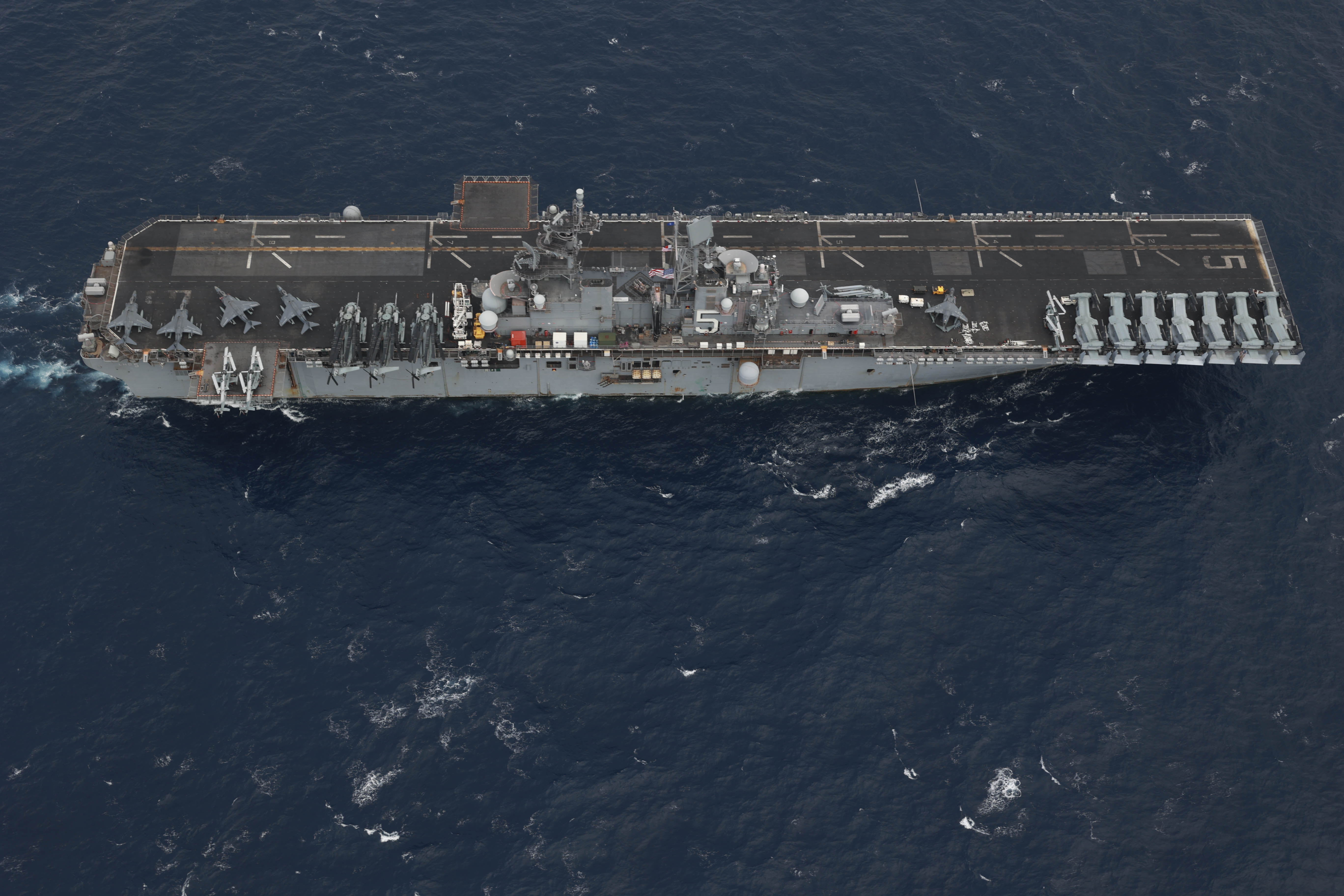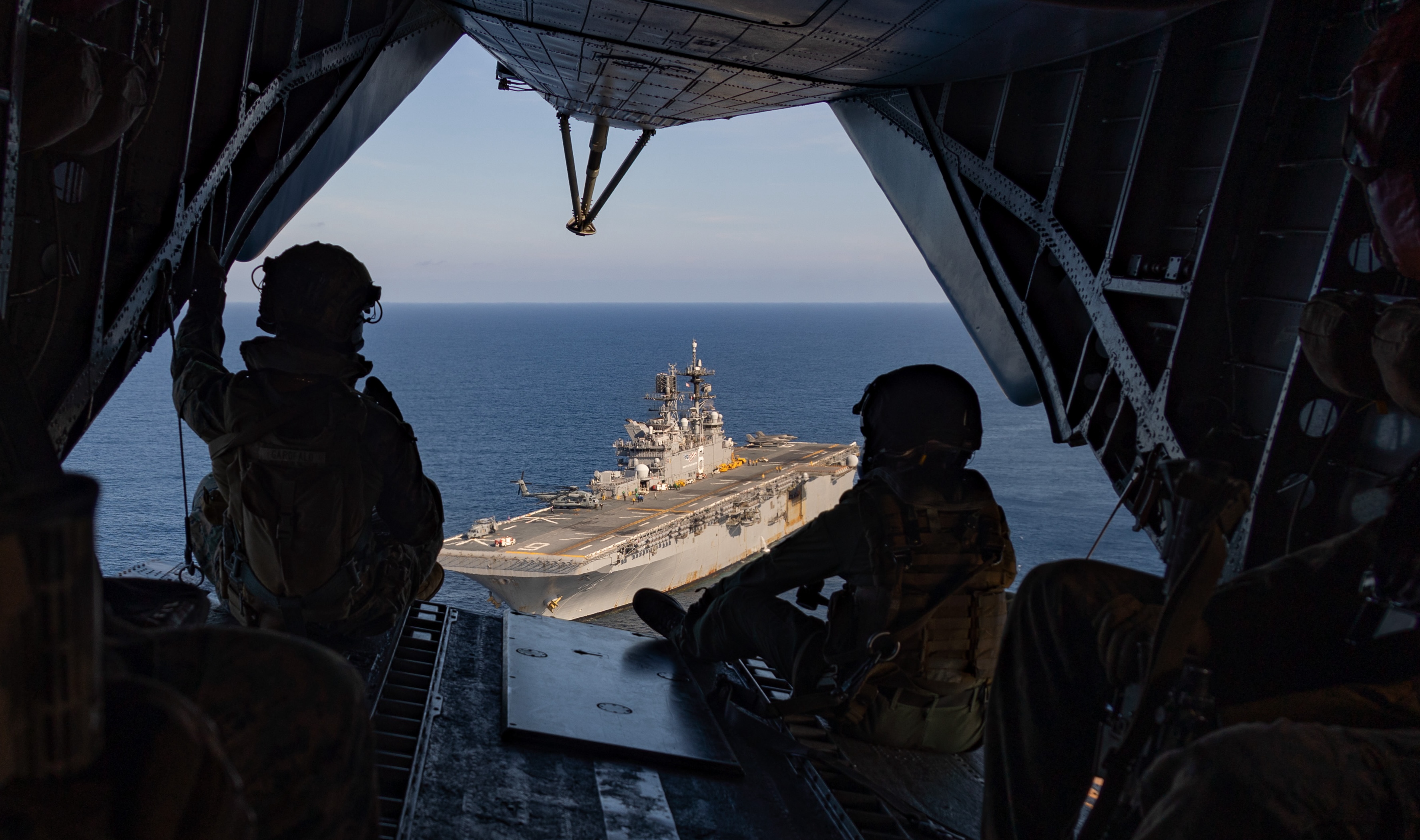
The Bataan Amphibious Ready Group and embarked 26th Marine Expeditionary Unit have wrapped up their Middle East and Europe deployment and are now homeward bound. Meanwhile, on the other side of the globe, elements of the America ARG will begin drills with the Japan Maritime Self-Defence Force (JMSDF) on Thursday.
The Bataan ARG, comprised of big deck amphibious ship USS Bataan (LHD-5), amphibious dock landing ship USS Carter Hall (LSD-50), and amphibious transport dock ship USS Mesa Verde (LPD-19), transited the Strait of Gibraltar and exited the Mediterranean Sea on Wednesday. The ARG and MEU will now sail across the Atlantic Ocean and return home to Norfolk, Va., and Camp LeJeune, N.C.
Entering the Atlantic Ocean is one of the final actions of the Bataan ARG’s and the 26th MEU’s nearly 8-month deployment, according to the USNI News Fleet and Marine Tracker. As of Wednesday, the Bataan ARG has been deployed for 240 days.
Since December, the Bataan ARG and the 26th MEU(SOC) have conducted training, exercises and operations in the U.S. European Command and U.S. Africa Command areas of responsibility in support of maritime stability and security in defense of U.S., allied and partner interests.
“Throughout our time in the U.S. Fifth and U.S. Sixth Fleet regions, the sailors and Marines of the Bataan ARG and 26th MEU showcased the unique capabilities that we bring as a response force to our allies and partners,” said Amphibious Squadron 8 Commodore, Capt. Martin Robertson, in the release. “Our presence in the Eastern Mediterranean was exactly what our nation needed: An integrated Navy and Marine Corps force ready to respond when called upon.”
The Bataan ARG departed the United States on July 10 but initially operated in a disaggregate deployment, with Mesa Verde operating in Norway and the Baltic region before operating in the Mediterranean from October, while Bataan and Carter Hall deployed to the Middle East. The ARG reformed at the end of the year in the Eastern Mediterranean and has since been operating in the Mediterranean.
Following the Hamas attacks in southern Israel, the ARG was positioned in the Eastern Mediterranean in the event of a regional noncombatant evacuation, several defense officials told USNI News.
On the other side of the globe, elements of the America ARG will begin drills with the JMSDF on Thursday, according to a Wednesday release by the JMSDF. “The JMSDF will conduct a bilateral exercise with the U.S. Navy (USN) in order to strengthen the capability of Japan-U.S. Alliance for effective deterrence and response,” announced the release.

Amphibious assault ship USS America (LHA-6), amphibious transport dock ship USS Green Bay (LPD-20) and mine countermeasures ship USS Warrior (MCM-10) will drill with JMSDF landing ship tank JS Kunisaki (LST-4003) and minesweeper JS Etajima (MSO-306) from Thursday to Mar. 16, south of the main island of Kyushu and also from the East China Sea to around Okinawa, according to the release, which also stated that among the exercises carried out will be cross decking, boarding and LCAC maintenance. Although not stated in the release, the drills are part of the ongoing U.S.–Japan Iron Fist 24 exercise, which began on Feb. 25 and ends on Mar. 17.
Meanwhile, nearby in Korea, Marines from across III Marine Expeditionary Force (MEF), and from 1st Marine Division, I MEF, deployed from Japan and the United States to join their South Korean counterparts to exercise as the Combined Marine Component Command (CMCC) during Freedom Shield 24, according to a Marine Corps Monday release. “During the exercise, the CMCC will rehearse force-wide command and control of combined ROK-U.S. forces to improve their collective defensive posture,” read the release.
The release also stated that III MEF will have units conducting field training exercises with their Republic of Korea (ROK) Marine Corps counterparts, consisting of close-air support training, live-fire training events, logistics training and subject-matter expert exchanges. A separate release stated the exercise provides an opportunity to execute command post operations at scale to validate capabilities, tactics, technique and procedures with the 1st ROK Marine Corps Division, and that the 1st ROK Marine Division and 1st Marine Division will use Freedom Shield 24 as an opportunity to displace the division command post and fight out of a combined forward command post. Neither release disclosed the number of Marines deployed for the drills
Freedom Shield 24, which began on Monday and ends on Mar. 14, is an annual exercise that “aims to build understanding between the Tri-Command and ROK Joint Chiefs of Staff (JCS), ensuring their ability to fortify the combined defense posture and enhance Alliance response capabilities against a spectrum of security threats. It will feature live, virtual, constructive, and field-based training, engaging personnel from the military services and other federal agencies,” read a U.S. Forces Korea release. The release also stated that a key aspect of the drill focuses on “conducting multi-domain operations leveraging land, sea, air, cyber, and space assets with emphasis on counter nuclear operations and nonkinetic effects.”





